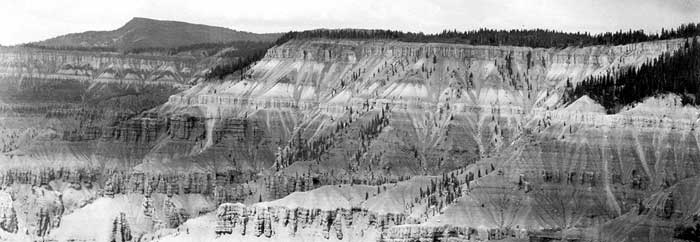Cedar Breaks - Historic Sites and Structures

By 1921, the Adams Family had built a lodge, known as "Minnie's Mansion," in what is now the northern section of the Monument. The Mansion offered dining, lodging, and dancing to area residents. Old timers recall that people came from as far away as Nevada to attend Utah Pioneer Day celebrations on July 24. Minnie's Mansion was short-lived...the summer seasons weren't long enough to turn a profit, and the establishment closed within five years. Today only traces of its foundations can be found.
The railroad hoped to attract rail passengers by developing a "loop tour" starting in Cedar City and connecting Zion, Bryce, the North Rim of the Grand Canyon, and Cedar Breaks. "Dudes," as the tourists were known, traveled in small tour buses driven by "gear-jammers."
All the Utah Parks Company lodges were designed by Gilbert Stanley Underwood, who would later design the famous Awahnee Lodge at Yosemite. Cedar Breaks was the smallest of the lodges.
Utah Parks tour buses stopped at Cedar Breaks for dinner before heading back to the train depot in Cedar City. A dollar twenty-five bought a chicken dinner, complete with mashed potatoes, gravy, homemade bread and dessert. The Lodge seated 120 people—some nights the tables were set three times to accomodate tour buses and locals who had come up to spend the evening.

Enrollees were young men between the ages of 18 and 25 whose families were on federal relief. They agreed to send $25 of their $30 monthly paycheck home to support their families. In addition, they received room, board, clothing, and technical training.
In 1937 a detail of 27 men from the Zion CCC camp were detailed to Cedar Breaks to begin construction of a Visitor Center and Ranger Cabin.
These structures exhibit classic National Park Service rustic architecture. The log cabin style recalls America's pioneer heritage. The buildings are also designed to appear as if they are a natural part of the environment. The massive fireplaces and sweeping cut of the log ends make the buildings appear to rise out of the earth organically. Both buildings are on the national register of historic places.
"We got hailed on, we got snowed on, but we had a lot of fun doing the job."
"What upset me most in my life, really, was to go up there one time and find that beautiful old lodge, Cedar Breaks Lodge, was torn down, cleaned up, and hauled away. So many of us didn't know it was happening at all."
Ray Knell
Former "gear-jammer"
Utah Parks Company
Christine Barnes. Great Lodges of the National Parks. WW West Inc. , 2002.
Albert A. Good. Park and Recreation Structures. Princeton: Princeton Architectural Press, 1999.
---. Patterns from the Golden Age of Rustic Design: Park and Recreation Structures from the 1930s. Landham, MD: Robert Rinehart, 2003.
Linda Flint McClelland. Building the National Parks: Historic Landscape Design of the National Park Service. Baltimore: Johns Hopkins University Press, 1998.